Insect Pests of Turfgrass HORT 378 Integrated Pest/Disease
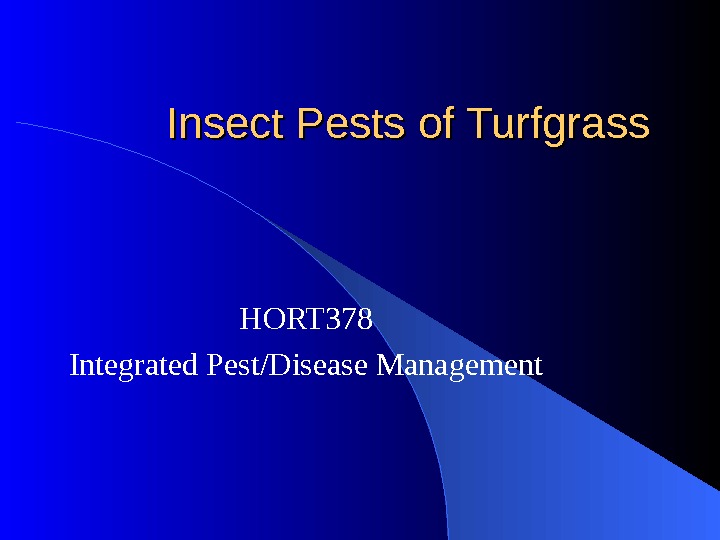
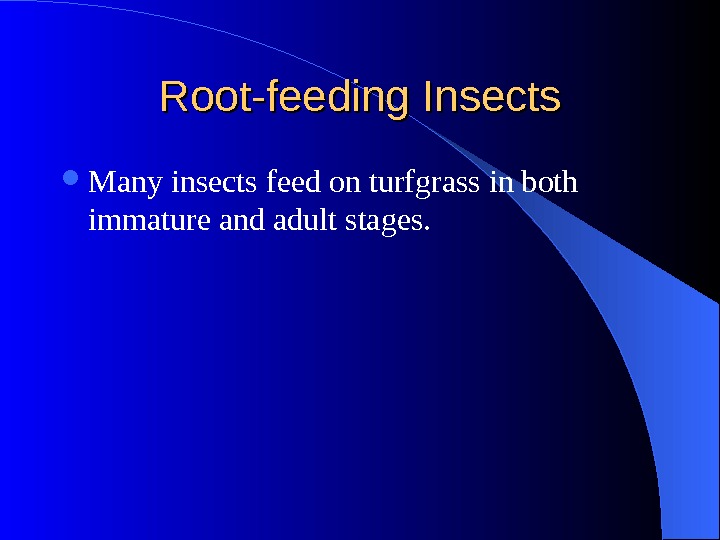
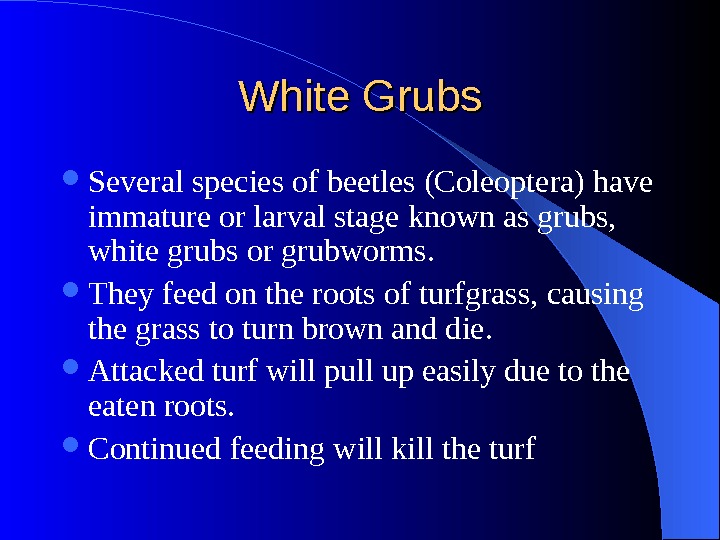
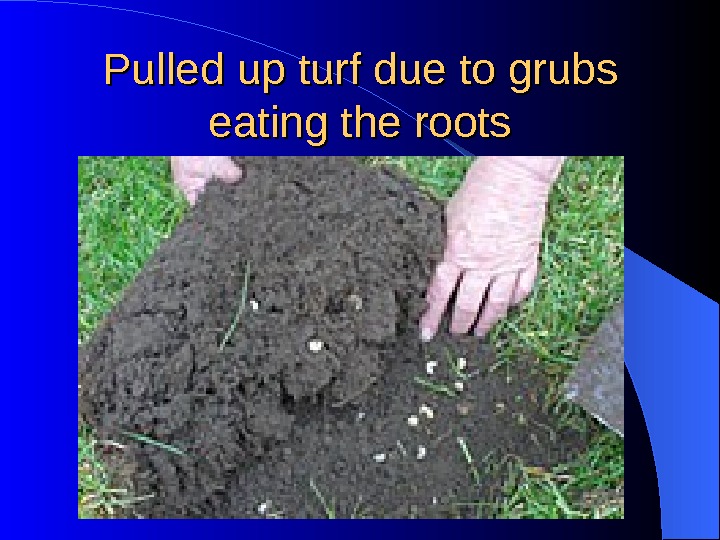
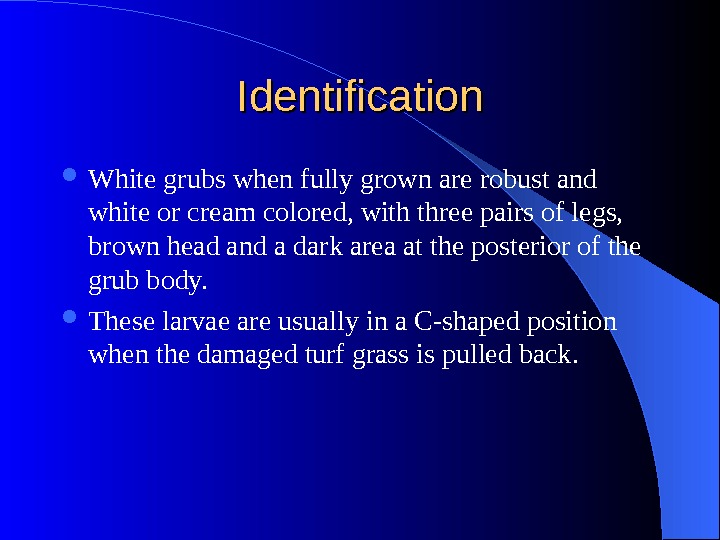
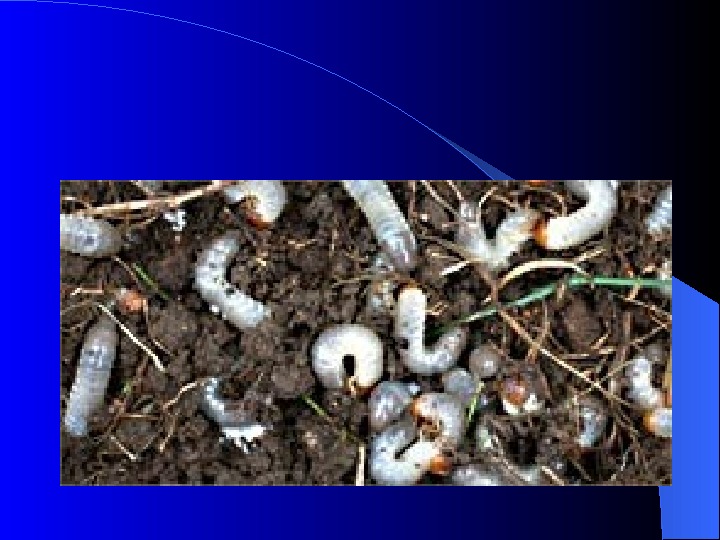
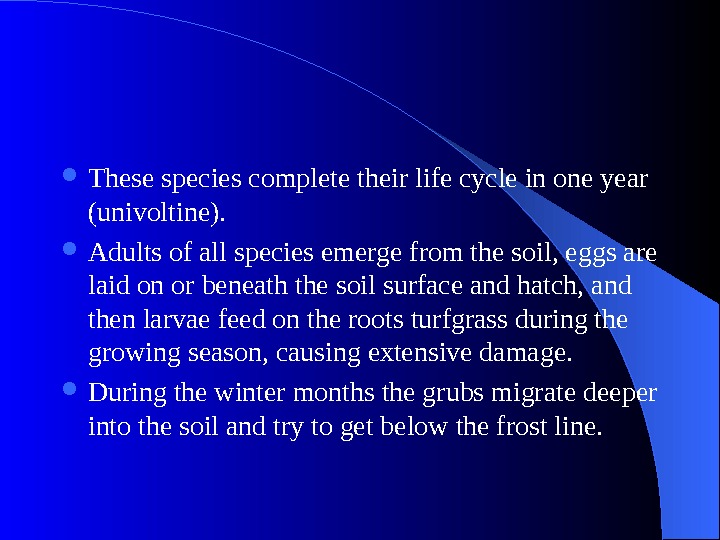


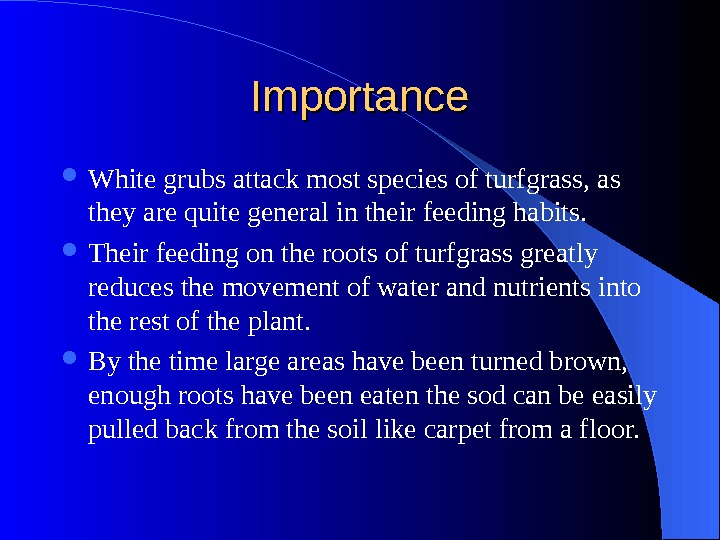

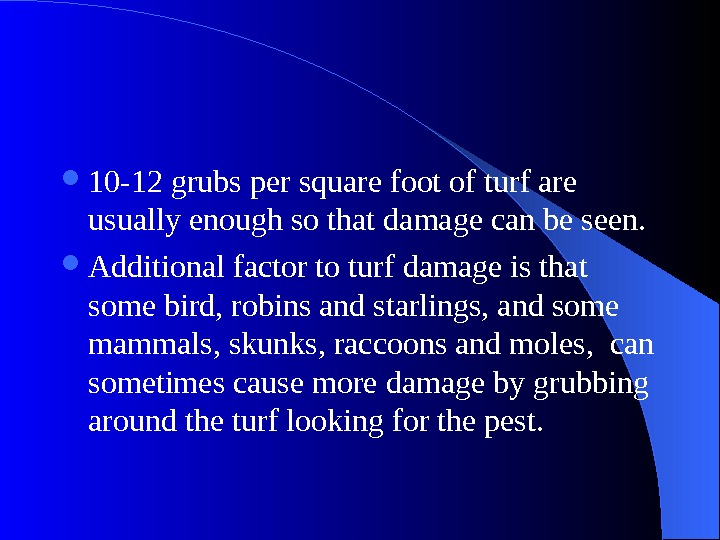
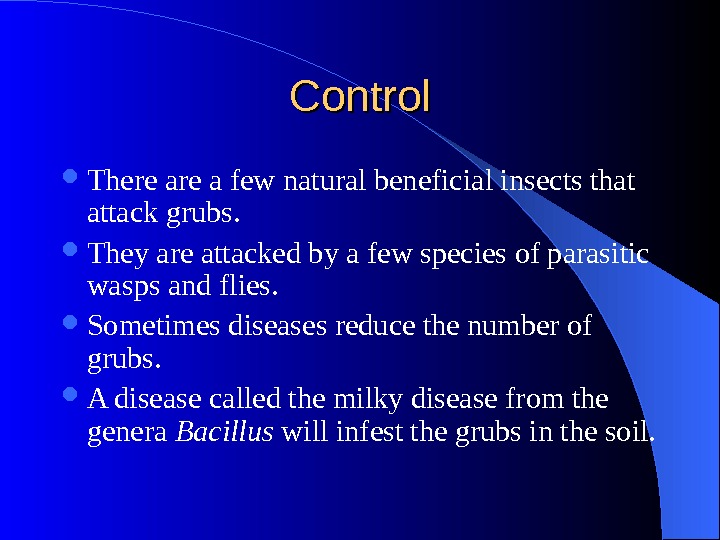
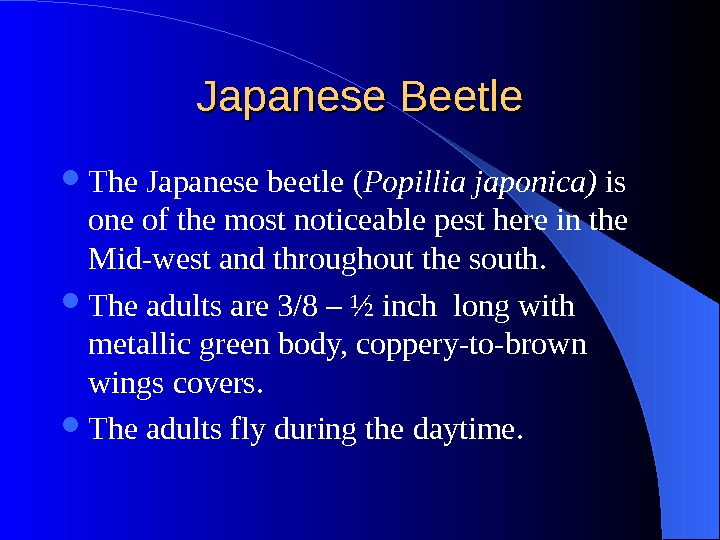
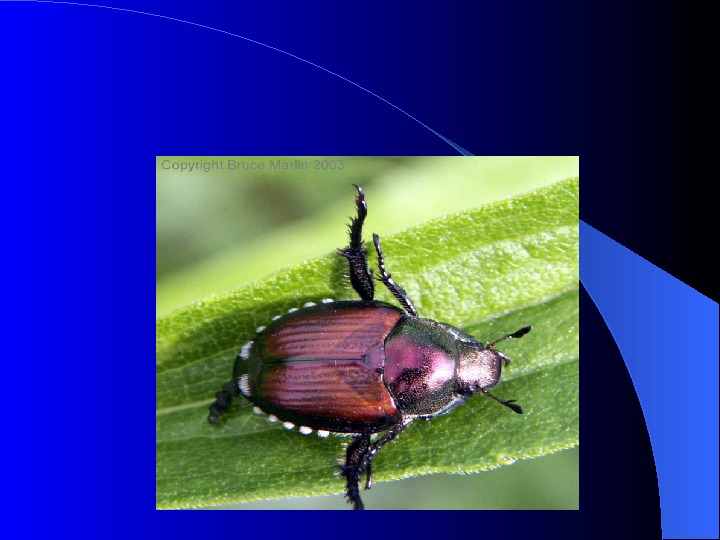
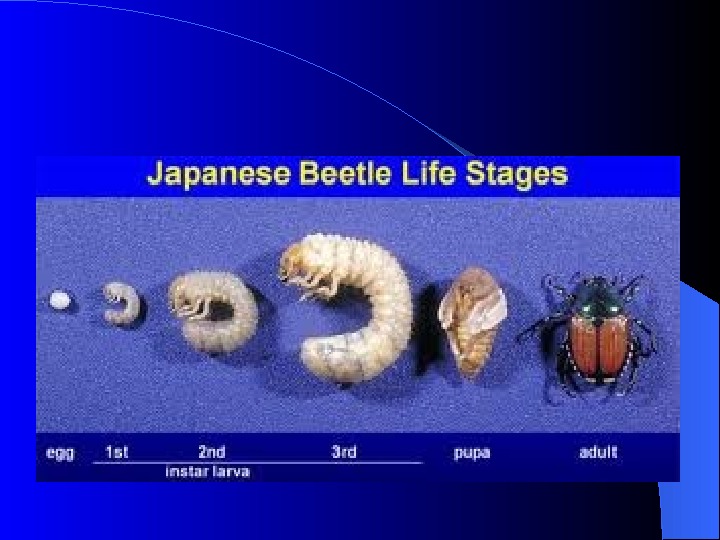

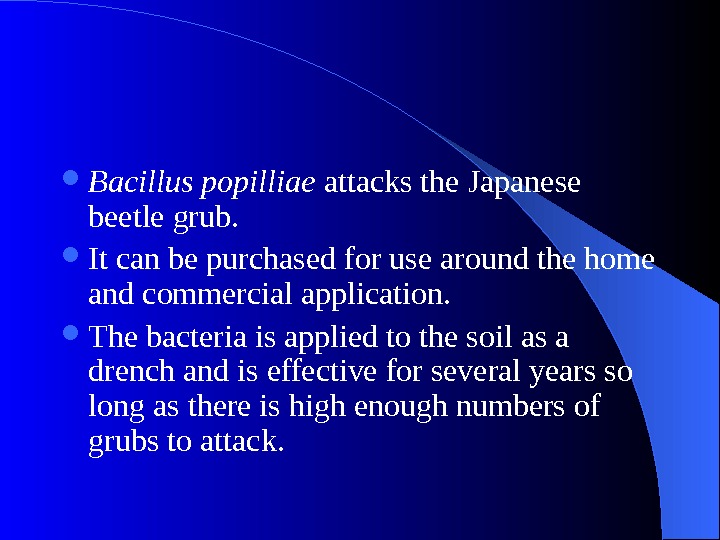
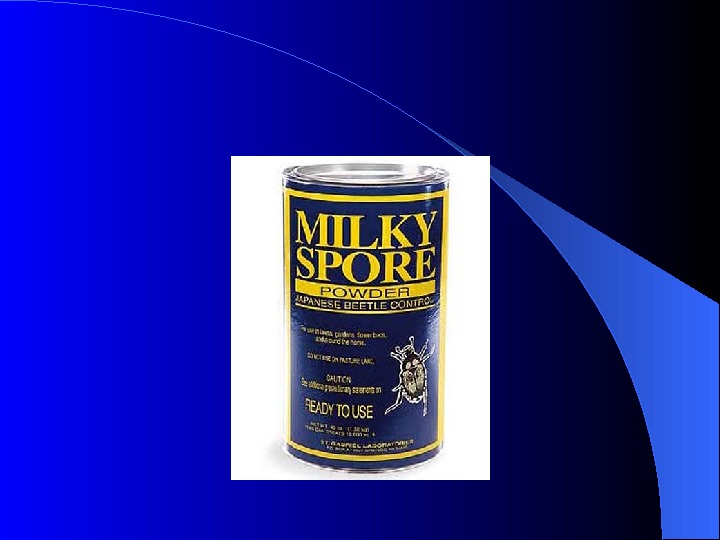
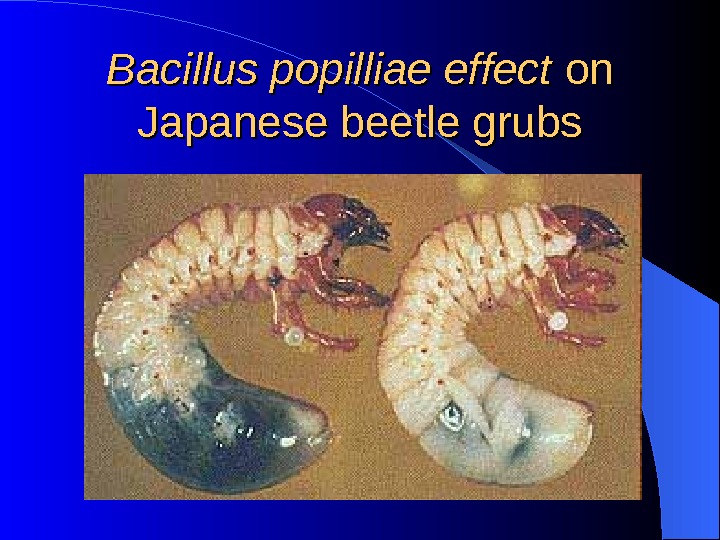

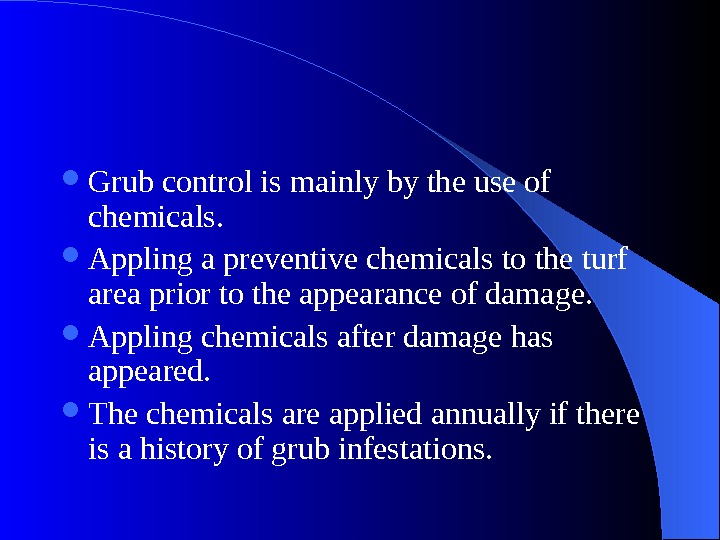
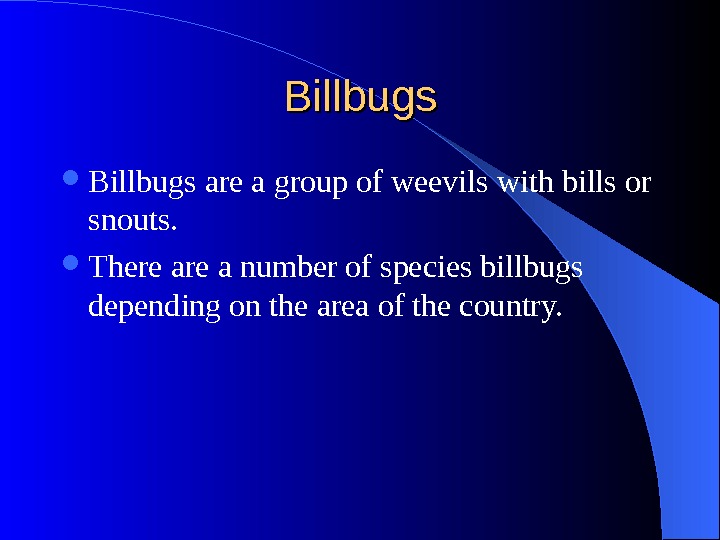
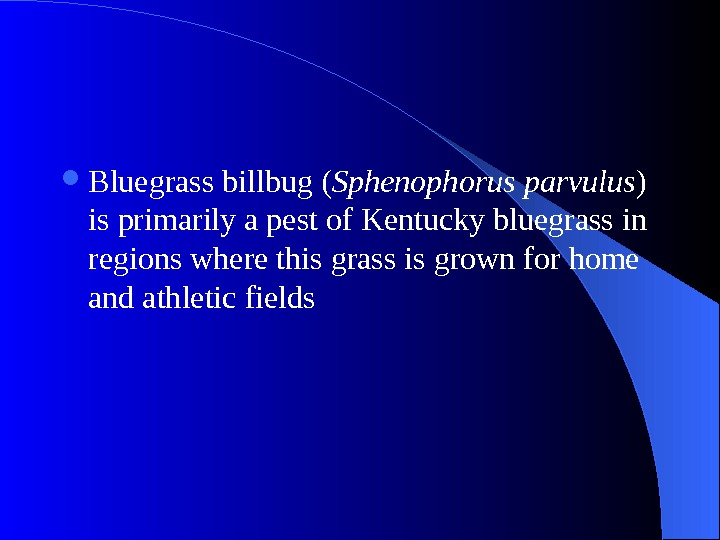
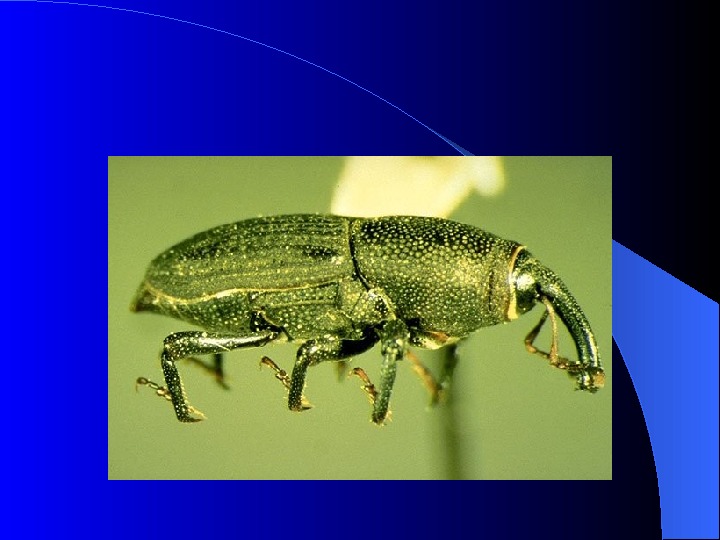
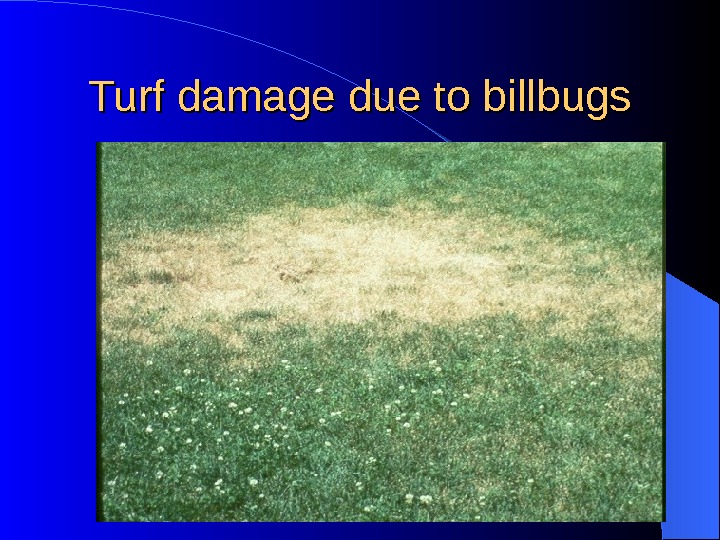
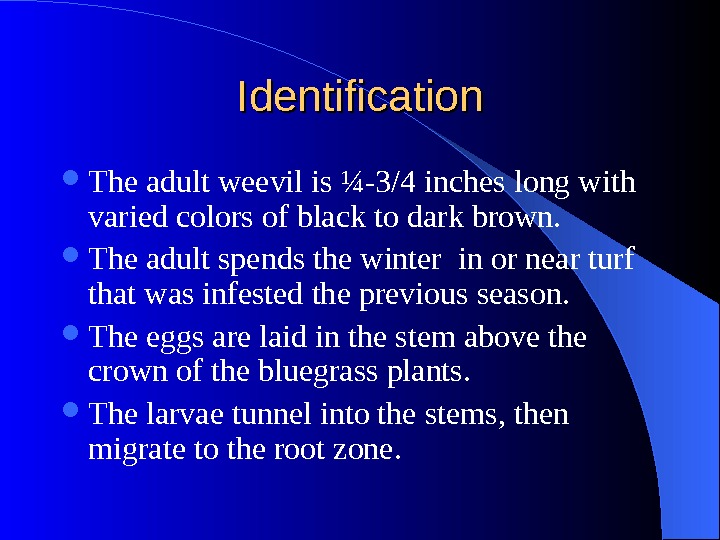
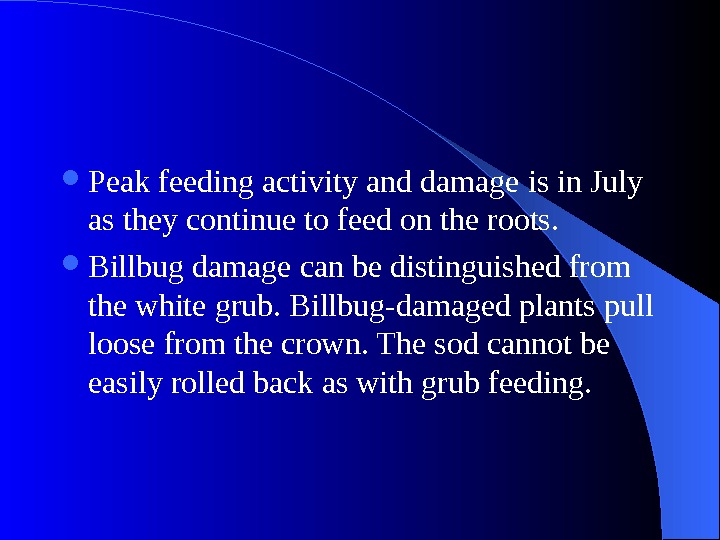
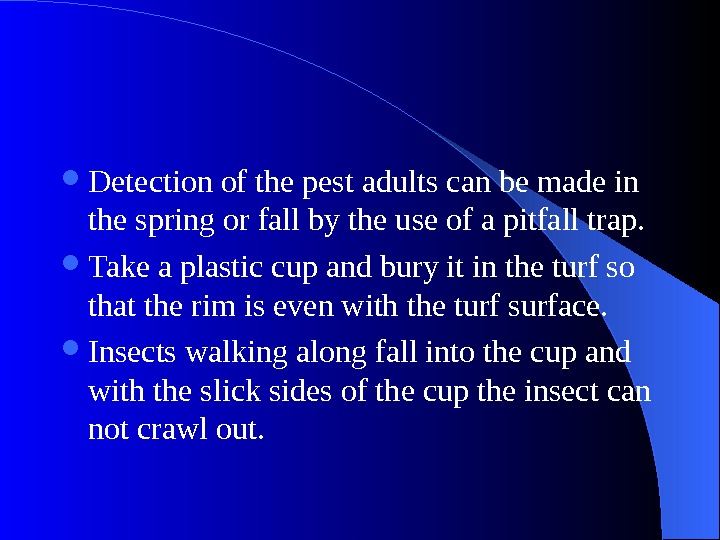
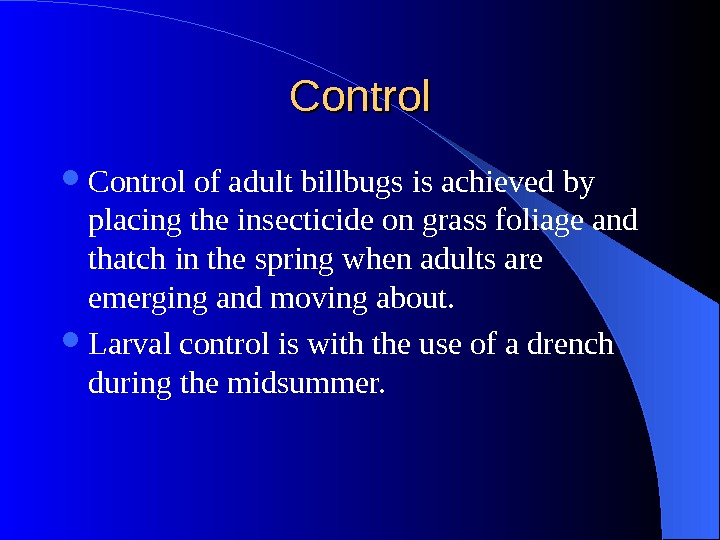
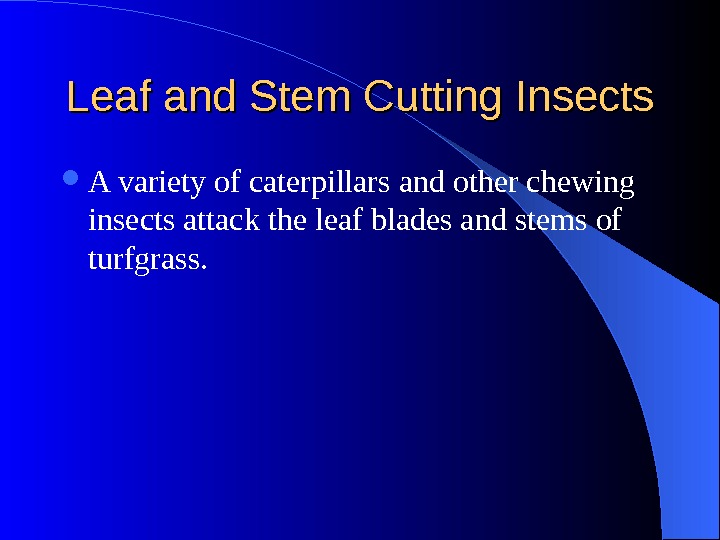
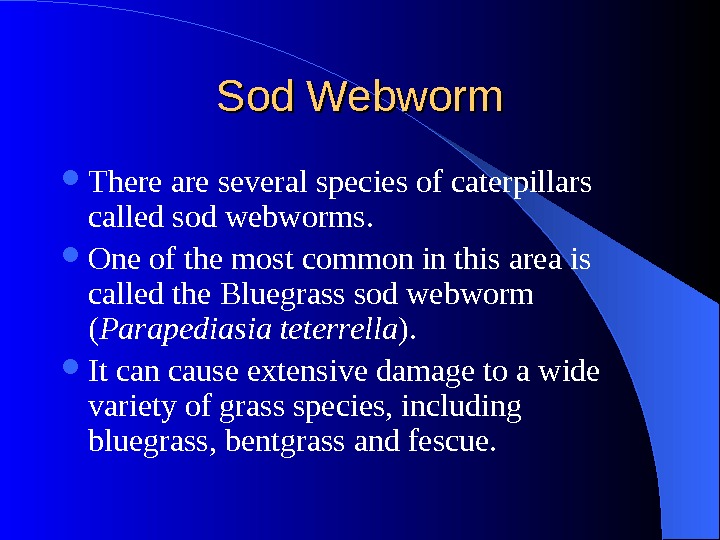

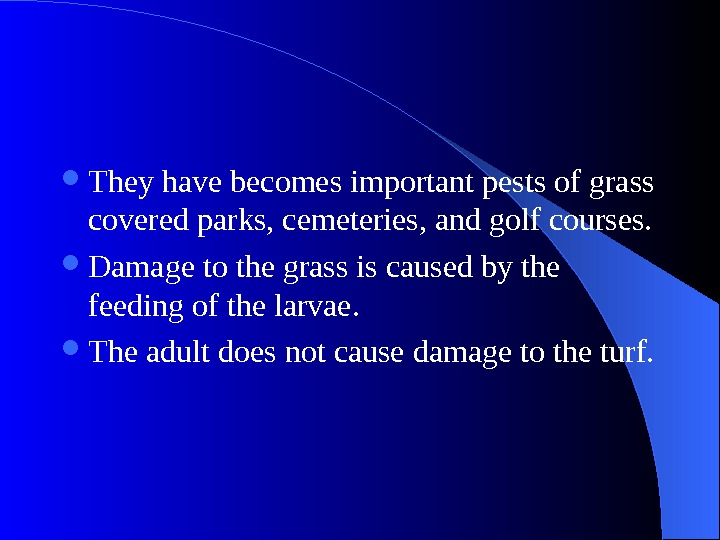
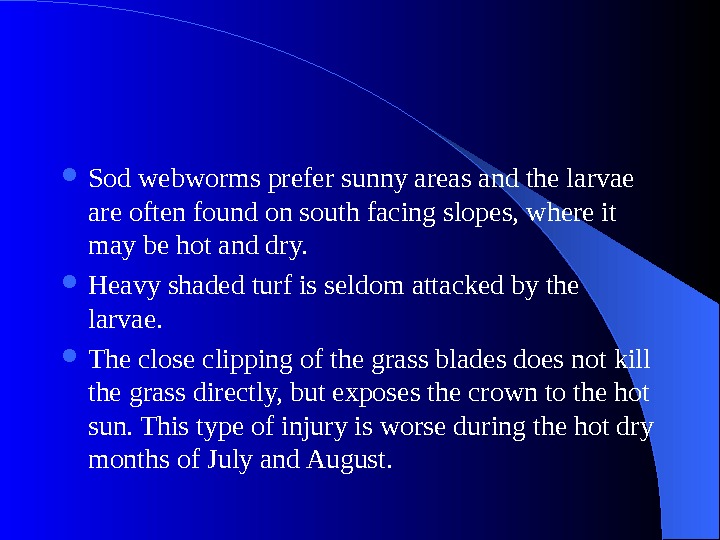
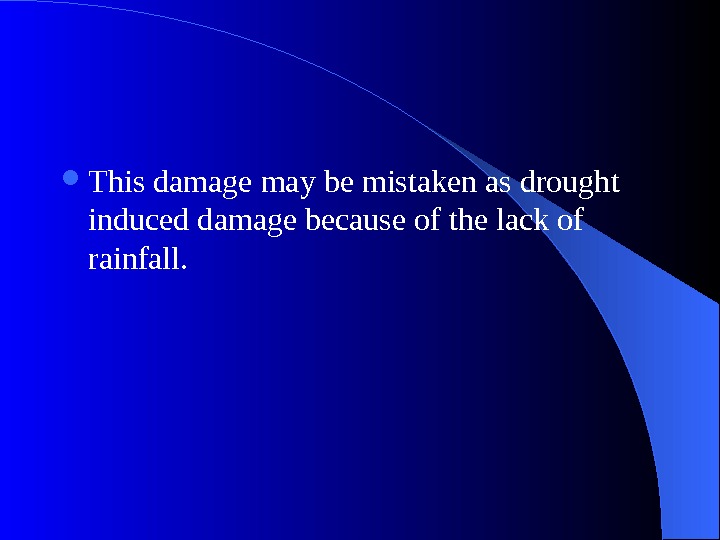
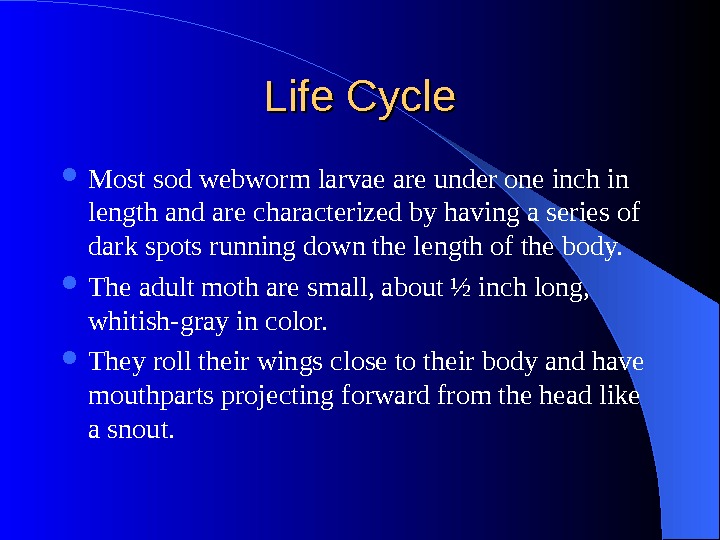
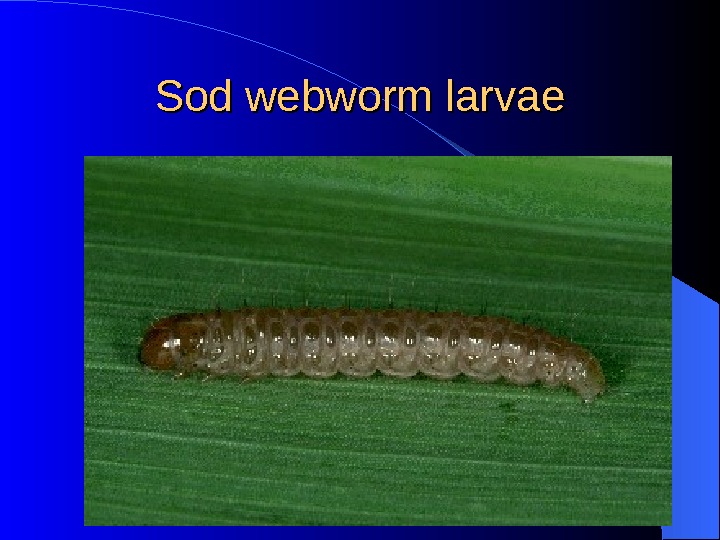
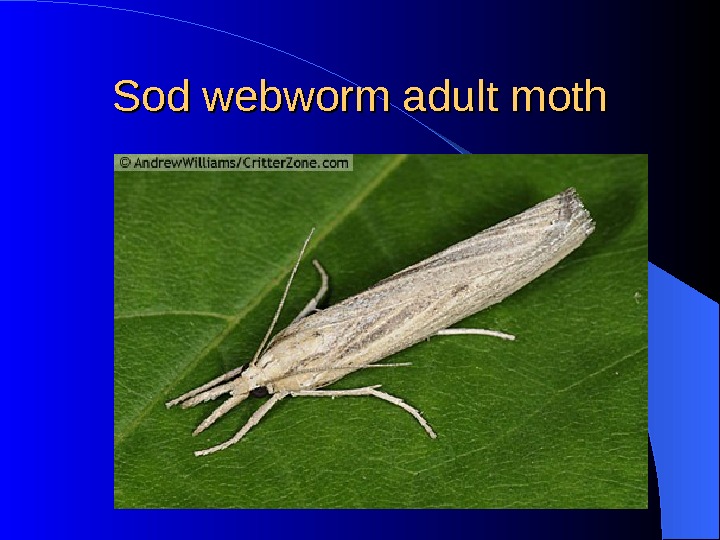

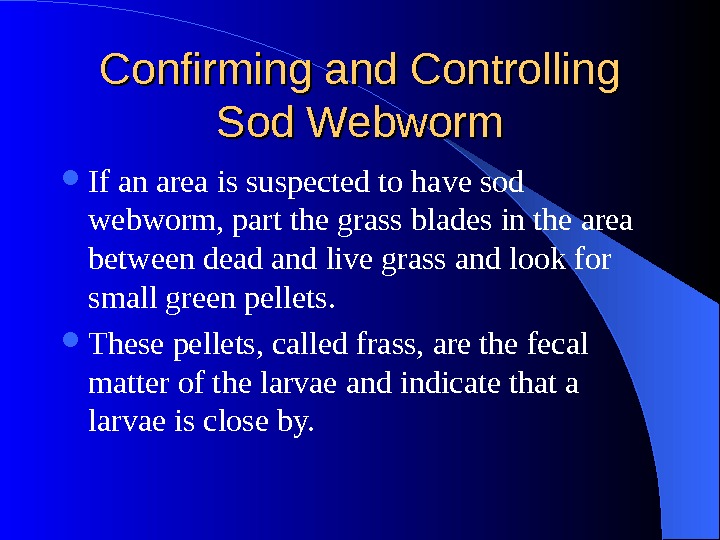
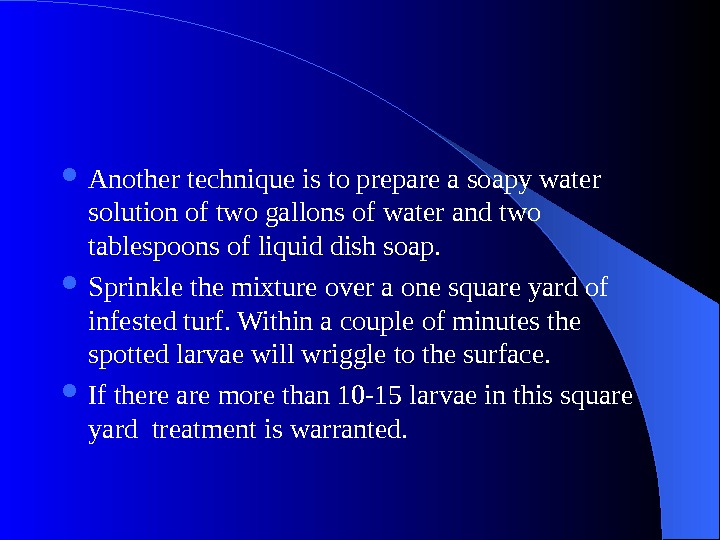
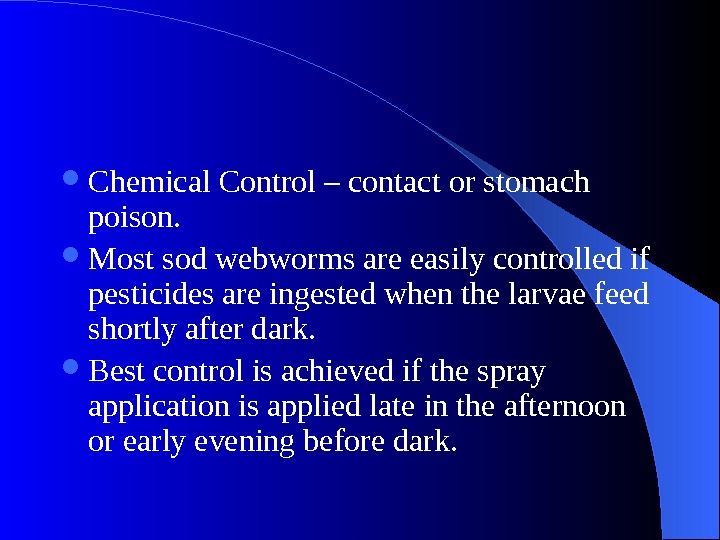

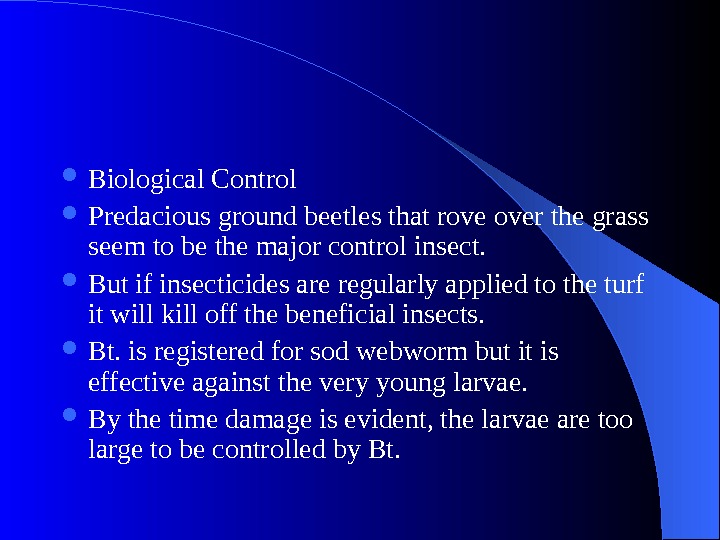
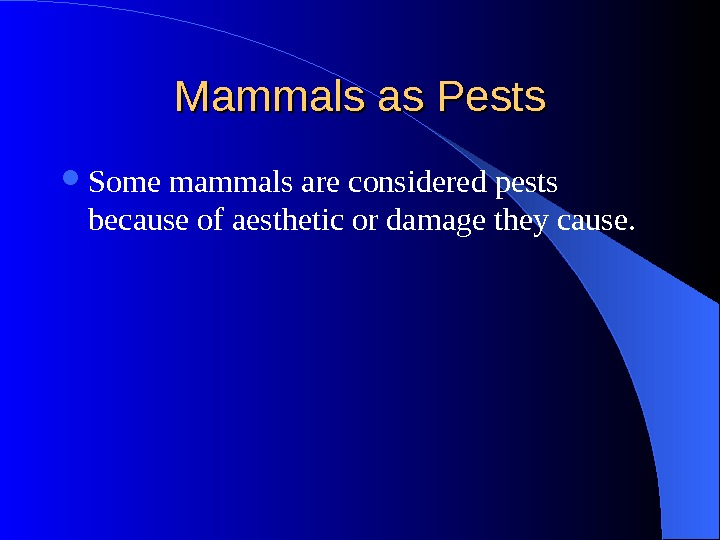
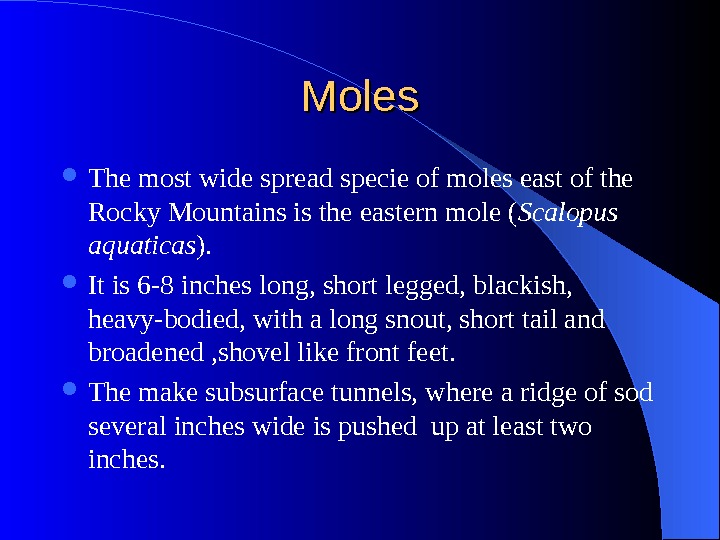
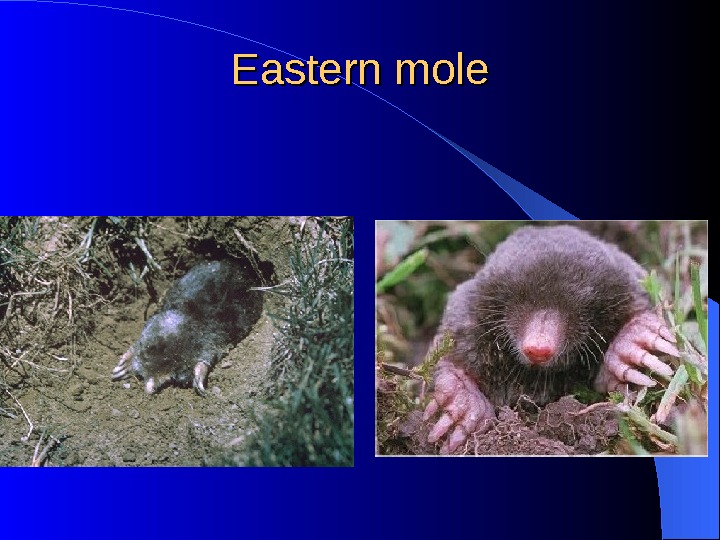
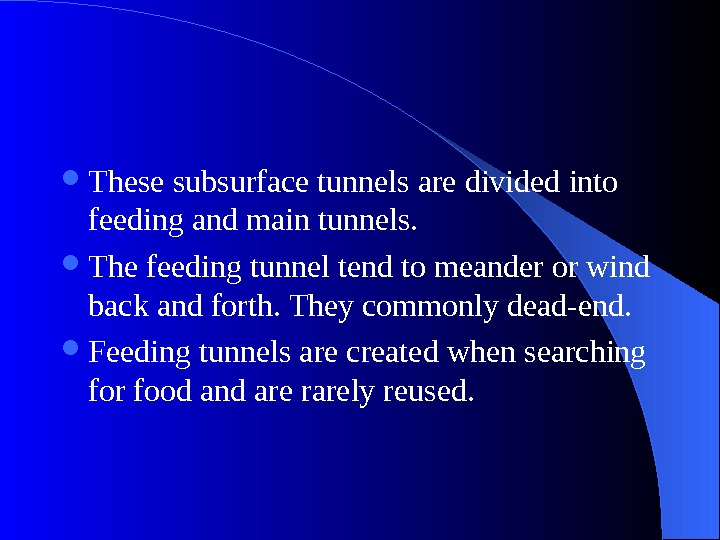
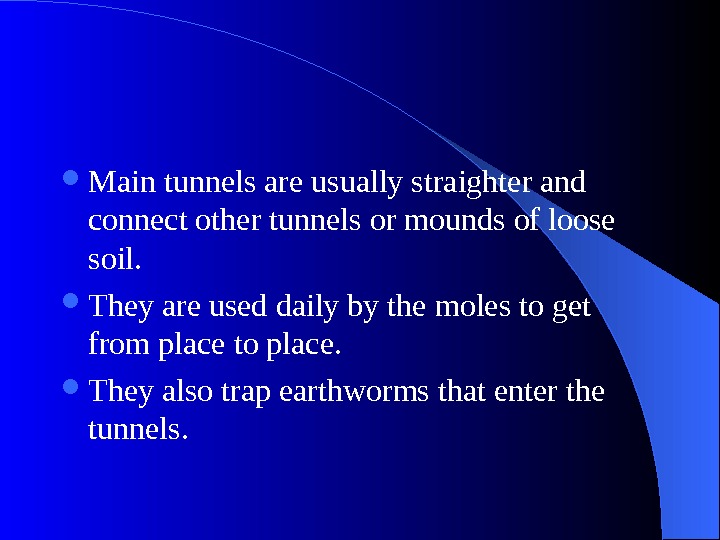
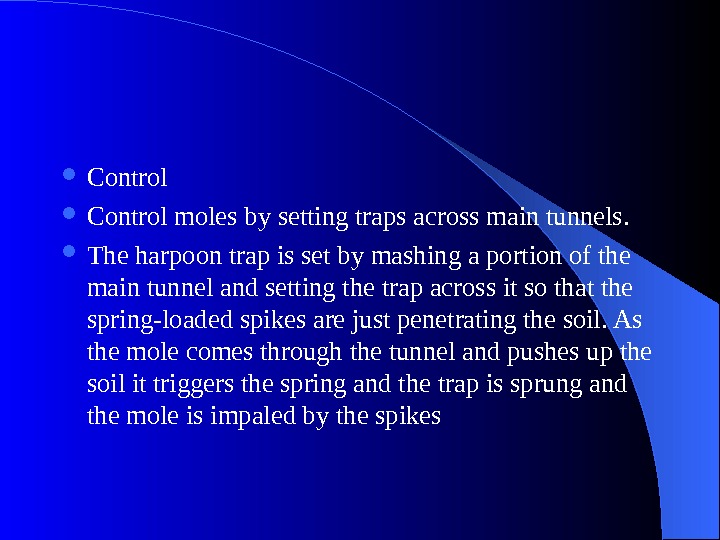
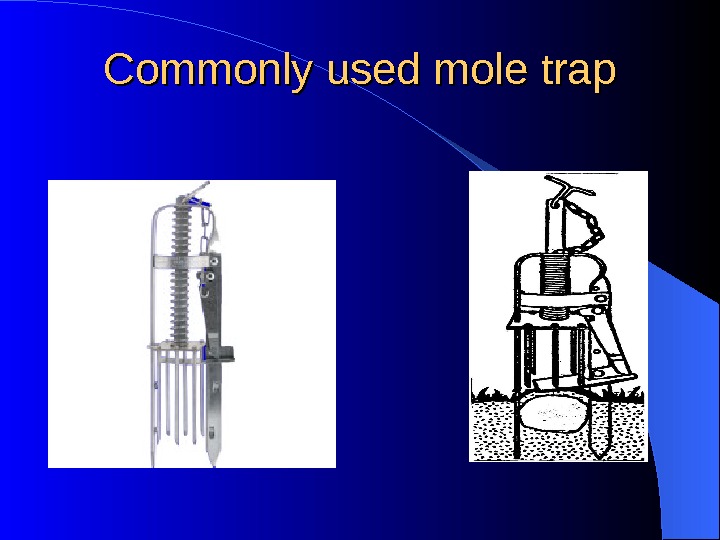
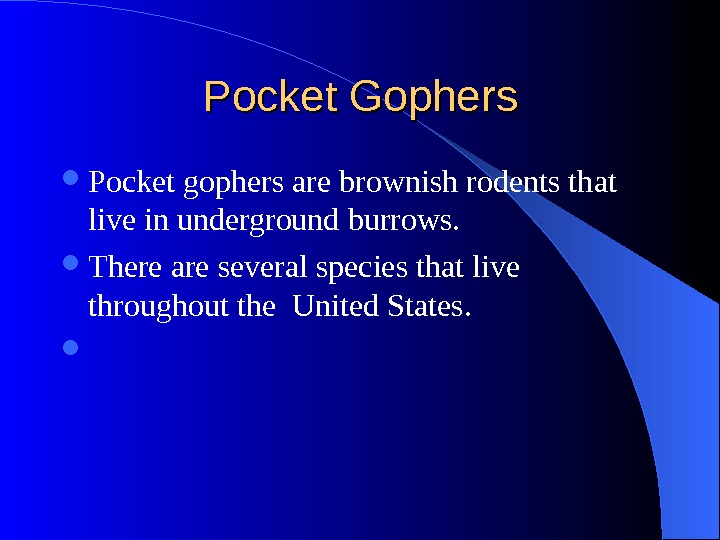

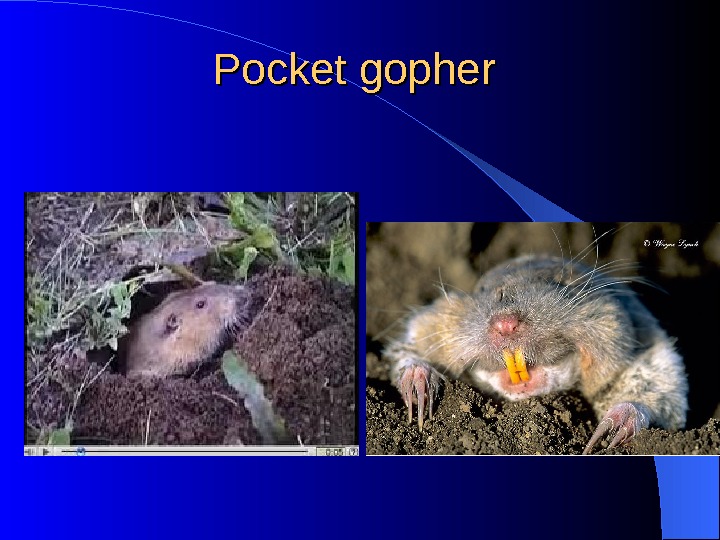
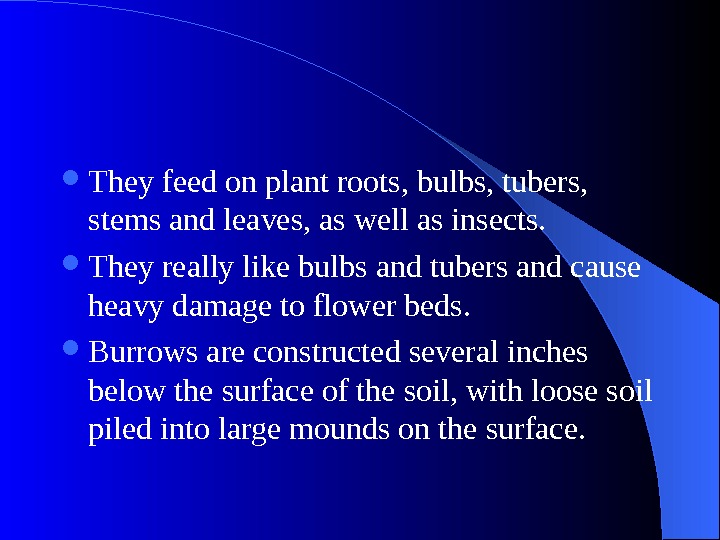
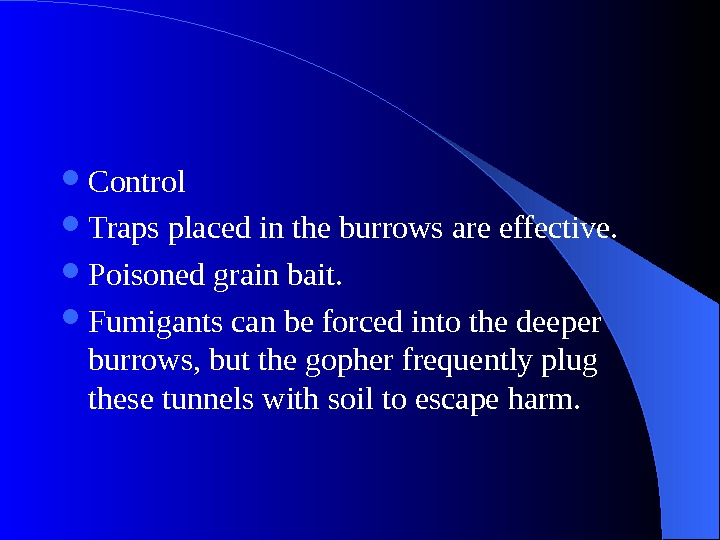
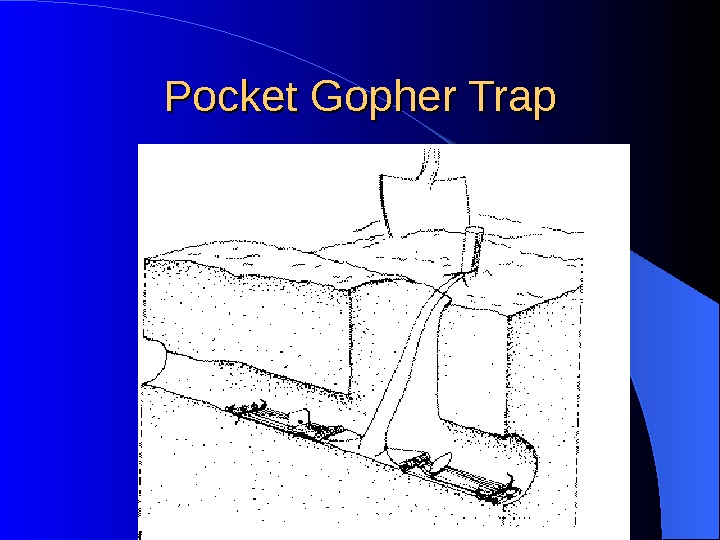
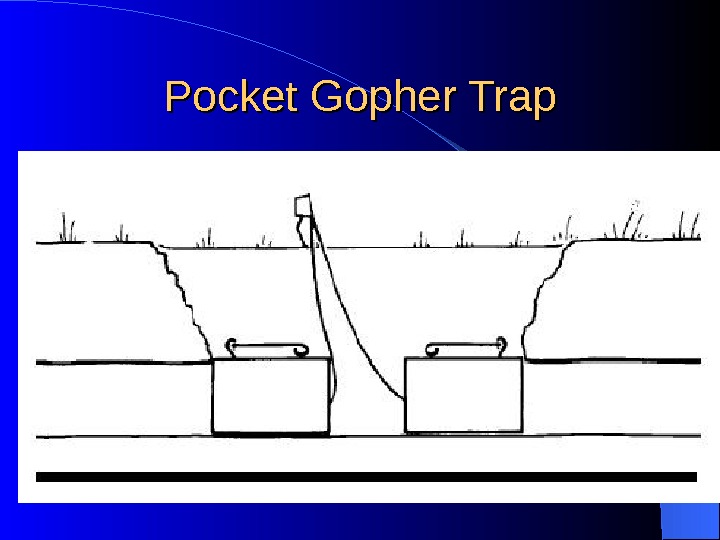
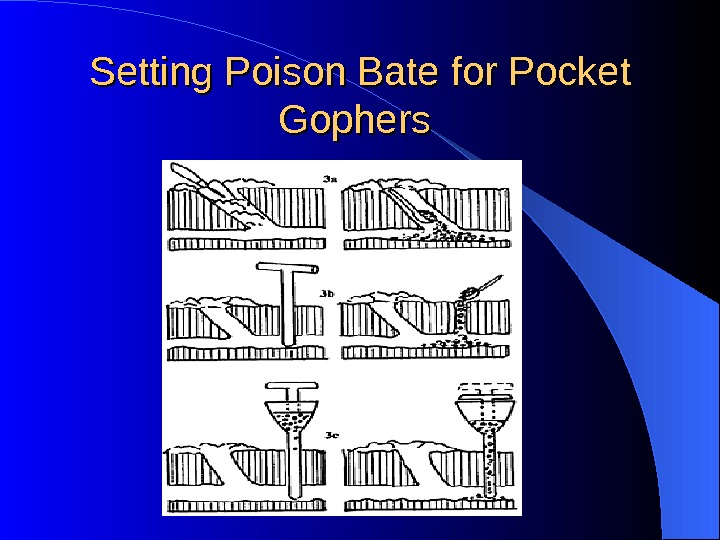
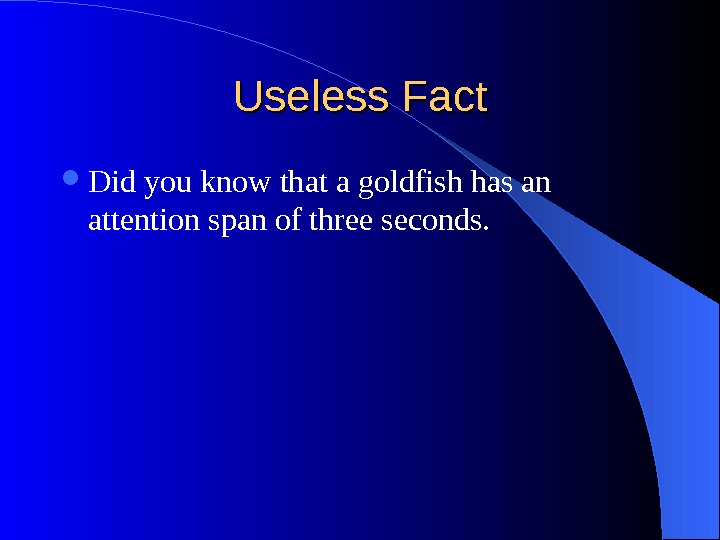

insects_pest_of_turfgrass.ppt
- Размер: 1.8 Mегабайта
- Количество слайдов: 62
Описание презентации Insect Pests of Turfgrass HORT 378 Integrated Pest/Disease по слайдам
 Insect Pests of Turfgrass HORT 378 Integrated Pest/Disease Management
Insect Pests of Turfgrass HORT 378 Integrated Pest/Disease Management
 Root-feeding Insects Many insects feed on turfgrass in both immature and adult stages.
Root-feeding Insects Many insects feed on turfgrass in both immature and adult stages.
 White Grubs Several species of beetles (Coleoptera) have immature or larval stage known as grubs, white grubs or grubworms. They feed on the roots of turfgrass, causing the grass to turn brown and die. Attacked turf will pull up easily due to the eaten roots. Continued feeding will kill the turf
White Grubs Several species of beetles (Coleoptera) have immature or larval stage known as grubs, white grubs or grubworms. They feed on the roots of turfgrass, causing the grass to turn brown and die. Attacked turf will pull up easily due to the eaten roots. Continued feeding will kill the turf
 Pulled up turf due to grubs eating the roots
Pulled up turf due to grubs eating the roots
 Identification White grubs when fully grown are robust and white or cream colored, with three pairs of legs, brown head and a dark area at the posterior of the grub body. These larvae are usually in a C-shaped position when the damaged turf grass is pulled back.
Identification White grubs when fully grown are robust and white or cream colored, with three pairs of legs, brown head and a dark area at the posterior of the grub body. These larvae are usually in a C-shaped position when the damaged turf grass is pulled back.

 These species complete their life cycle in one year (univoltine). Adults of all species emerge from the soil, eggs are laid on or beneath the soil surface and hatch, and then larvae feed on the roots turfgrass during the growing season, causing extensive damage. During the winter months the grubs migrate deeper into the soil and try to get below the frost line.
These species complete their life cycle in one year (univoltine). Adults of all species emerge from the soil, eggs are laid on or beneath the soil surface and hatch, and then larvae feed on the roots turfgrass during the growing season, causing extensive damage. During the winter months the grubs migrate deeper into the soil and try to get below the frost line.
 Beetle Life Cycle
Beetle Life Cycle
 Many of the adults also cause extensive damage to landscape and some vegetable crops.
Many of the adults also cause extensive damage to landscape and some vegetable crops.
 Importance White grubs attack most species of turfgrass, as they are quite general in their feeding habits. Their feeding on the roots of turfgrass greatly reduces the movement of water and nutrients into the rest of the plant. By the time large areas have been turned brown, enough roots have been eaten the sod can be easily pulled back from the soil like carpet from a floor.
Importance White grubs attack most species of turfgrass, as they are quite general in their feeding habits. Their feeding on the roots of turfgrass greatly reduces the movement of water and nutrients into the rest of the plant. By the time large areas have been turned brown, enough roots have been eaten the sod can be easily pulled back from the soil like carpet from a floor.
 Even heavily damaged sod that has turned completely brown and can be lifted up can regenerate within a few weeks if the grubs are killed and the sod is irrigated to regenerate lost root tissues. Number of grubs necessary to cause damage will depend on the soil type, moisture, turf species , etc.
Even heavily damaged sod that has turned completely brown and can be lifted up can regenerate within a few weeks if the grubs are killed and the sod is irrigated to regenerate lost root tissues. Number of grubs necessary to cause damage will depend on the soil type, moisture, turf species , etc.
 10 -12 grubs per square foot of turf are usually enough so that damage can be seen. Additional factor to turf damage is that some bird, robins and starlings, and some mammals, skunks, raccoons and moles, can sometimes cause more damage by grubbing around the turf looking for the pest.
10 -12 grubs per square foot of turf are usually enough so that damage can be seen. Additional factor to turf damage is that some bird, robins and starlings, and some mammals, skunks, raccoons and moles, can sometimes cause more damage by grubbing around the turf looking for the pest.
 Control There a few natural beneficial insects that attack grubs. They are attacked by a few species of parasitic wasps and flies. Sometimes diseases reduce the number of grubs. A disease called the milky disease from the genera Bacillus will infest the grubs in the soil.
Control There a few natural beneficial insects that attack grubs. They are attacked by a few species of parasitic wasps and flies. Sometimes diseases reduce the number of grubs. A disease called the milky disease from the genera Bacillus will infest the grubs in the soil.
 Japanese Beetle The Japanese beetle ( Popillia japonica) is one of the most noticeable pest here in the Mid-west and throughout the south. The adults are 3/8 – ½ inch long with metallic green body, coppery-to-brown wings covers. The adults fly during the daytime.
Japanese Beetle The Japanese beetle ( Popillia japonica) is one of the most noticeable pest here in the Mid-west and throughout the south. The adults are 3/8 – ½ inch long with metallic green body, coppery-to-brown wings covers. The adults fly during the daytime.


 As adults they feed heavily on leaves, flowers and fruit of more than 200 different plants. They really like grape leaves. One of the control measures is to get rid of wild grape vines in wooded areas that may be close to vineyards.
As adults they feed heavily on leaves, flowers and fruit of more than 200 different plants. They really like grape leaves. One of the control measures is to get rid of wild grape vines in wooded areas that may be close to vineyards.
 Bacillus popilliae attacks the Japanese beetle grub. It can be purchased for use around the home and commercial application. The bacteria is applied to the soil as a drench and is effective for several years so long as there is high enough numbers of grubs to attack.
Bacillus popilliae attacks the Japanese beetle grub. It can be purchased for use around the home and commercial application. The bacteria is applied to the soil as a drench and is effective for several years so long as there is high enough numbers of grubs to attack.

 Bacillus popilliae effect on on Japanese beetle grubs
Bacillus popilliae effect on on Japanese beetle grubs
 Trapping by way of pheromone sex traps.
Trapping by way of pheromone sex traps.
 Grub control is mainly by the use of chemicals. Appling a preventive chemicals to the turf area prior to the appearance of damage. Appling chemicals after damage has appeared. The chemicals are applied annually if there is a history of grub infestations.
Grub control is mainly by the use of chemicals. Appling a preventive chemicals to the turf area prior to the appearance of damage. Appling chemicals after damage has appeared. The chemicals are applied annually if there is a history of grub infestations.
 Billbugs are a group of weevils with bills or snouts. There a number of species billbugs depending on the area of the country.
Billbugs are a group of weevils with bills or snouts. There a number of species billbugs depending on the area of the country.
 Bluegrass billbug ( Sphenophorus parvulus ) is primarily a pest of Kentucky bluegrass in regions where this grass is grown for home and athletic fields
Bluegrass billbug ( Sphenophorus parvulus ) is primarily a pest of Kentucky bluegrass in regions where this grass is grown for home and athletic fields

 Turf damage due to billbugs
Turf damage due to billbugs
 Identification The adult weevil is ¼-3/4 inches long with varied colors of black to dark brown. The adult spends the winter in or near turf that was infested the previous season. The eggs are laid in the stem above the crown of the bluegrass plants. The larvae tunnel into the stems, then migrate to the root zone.
Identification The adult weevil is ¼-3/4 inches long with varied colors of black to dark brown. The adult spends the winter in or near turf that was infested the previous season. The eggs are laid in the stem above the crown of the bluegrass plants. The larvae tunnel into the stems, then migrate to the root zone.
 Peak feeding activity and damage is in July as they continue to feed on the roots. Billbug damage can be distinguished from the white grub. Billbug-damaged plants pull loose from the crown. The sod cannot be easily rolled back as with grub feeding.
Peak feeding activity and damage is in July as they continue to feed on the roots. Billbug damage can be distinguished from the white grub. Billbug-damaged plants pull loose from the crown. The sod cannot be easily rolled back as with grub feeding.
 Detection of the pest adults can be made in the spring or fall by the use of a pitfall trap. Take a plastic cup and bury it in the turf so that the rim is even with the turf surface. Insects walking along fall into the cup and with the slick sides of the cup the insect can not crawl out.
Detection of the pest adults can be made in the spring or fall by the use of a pitfall trap. Take a plastic cup and bury it in the turf so that the rim is even with the turf surface. Insects walking along fall into the cup and with the slick sides of the cup the insect can not crawl out.
 Control of adult billbugs is achieved by placing the insecticide on grass foliage and thatch in the spring when adults are emerging and moving about. Larval control is with the use of a drench during the midsummer.
Control of adult billbugs is achieved by placing the insecticide on grass foliage and thatch in the spring when adults are emerging and moving about. Larval control is with the use of a drench during the midsummer.
 Leaf and Stem Cutting Insects A variety of caterpillars and other chewing insects attack the leaf blades and stems of turfgrass.
Leaf and Stem Cutting Insects A variety of caterpillars and other chewing insects attack the leaf blades and stems of turfgrass.
 Sod Webworm There are several species of caterpillars called sod webworms. One of the most common in this area is called the Bluegrass sod webworm ( Parapediasia teterrella ). It can cause extensive damage to a wide variety of grass species, including bluegrass, bentgrass and fescue.
Sod Webworm There are several species of caterpillars called sod webworms. One of the most common in this area is called the Bluegrass sod webworm ( Parapediasia teterrella ). It can cause extensive damage to a wide variety of grass species, including bluegrass, bentgrass and fescue.

 They have becomes important pests of grass covered parks, cemeteries, and golf courses. Damage to the grass is caused by the feeding of the larvae. The adult does not cause damage to the turf.
They have becomes important pests of grass covered parks, cemeteries, and golf courses. Damage to the grass is caused by the feeding of the larvae. The adult does not cause damage to the turf.
 Sod webworms prefer sunny areas and the larvae are often found on south facing slopes, where it may be hot and dry. Heavy shaded turf is seldom attacked by the larvae. The close clipping of the grass blades does not kill the grass directly, but exposes the crown to the hot sun. This type of injury is worse during the hot dry months of July and August.
Sod webworms prefer sunny areas and the larvae are often found on south facing slopes, where it may be hot and dry. Heavy shaded turf is seldom attacked by the larvae. The close clipping of the grass blades does not kill the grass directly, but exposes the crown to the hot sun. This type of injury is worse during the hot dry months of July and August.
 This damage may be mistaken as drought induced damage because of the lack of rainfall.
This damage may be mistaken as drought induced damage because of the lack of rainfall.
 Life Cycle Most sod webworm larvae are under one inch in length and are characterized by having a series of dark spots running down the length of the body. The adult moth are small, about ½ inch long, whitish-gray in color. They roll their wings close to their body and have mouthparts projecting forward from the head like a snout.
Life Cycle Most sod webworm larvae are under one inch in length and are characterized by having a series of dark spots running down the length of the body. The adult moth are small, about ½ inch long, whitish-gray in color. They roll their wings close to their body and have mouthparts projecting forward from the head like a snout.
 Sod webworm larvae
Sod webworm larvae
 Sod webworm adult moth
Sod webworm adult moth
 The moths are noticed when flushed out by lawn mowing or people walking. When disturbed they fly in a jerky zig-zag manner and quickly return to the grass surface to hide.
The moths are noticed when flushed out by lawn mowing or people walking. When disturbed they fly in a jerky zig-zag manner and quickly return to the grass surface to hide.
 Confirming and Controlling Sod Webworm If an area is suspected to have sod webworm, part the grass blades in the area between dead and live grass and look for small green pellets. These pellets, called frass, are the fecal matter of the larvae and indicate that a larvae is close by.
Confirming and Controlling Sod Webworm If an area is suspected to have sod webworm, part the grass blades in the area between dead and live grass and look for small green pellets. These pellets, called frass, are the fecal matter of the larvae and indicate that a larvae is close by.
 Another technique is to prepare a soapy water solution of two gallons of water and two tablespoons of liquid dish soap. Sprinkle the mixture over a one square yard of infested turf. Within a couple of minutes the spotted larvae will wriggle to the surface. If there are more than 10 -15 larvae in this square yard treatment is warranted.
Another technique is to prepare a soapy water solution of two gallons of water and two tablespoons of liquid dish soap. Sprinkle the mixture over a one square yard of infested turf. Within a couple of minutes the spotted larvae will wriggle to the surface. If there are more than 10 -15 larvae in this square yard treatment is warranted.
 Chemical Control – contact or stomach poison. Most sod webworms are easily controlled if pesticides are ingested when the larvae feed shortly after dark. Best control is achieved if the spray application is applied late in the afternoon or early evening before dark.
Chemical Control – contact or stomach poison. Most sod webworms are easily controlled if pesticides are ingested when the larvae feed shortly after dark. Best control is achieved if the spray application is applied late in the afternoon or early evening before dark.
 Cultural Control – use fertilizer and water. Damage can be often overgrown if water and fertilizer are continually available. One problem with this is that the insects are still there. You are treating the symptoms but not the problem.
Cultural Control – use fertilizer and water. Damage can be often overgrown if water and fertilizer are continually available. One problem with this is that the insects are still there. You are treating the symptoms but not the problem.
 Biological Control Predacious ground beetles that rove over the grass seem to be the major control insect. But if insecticides are regularly applied to the turf it will kill off the beneficial insects. Bt. is registered for sod webworm but it is effective against the very young larvae. By the time damage is evident, the larvae are too large to be controlled by Bt.
Biological Control Predacious ground beetles that rove over the grass seem to be the major control insect. But if insecticides are regularly applied to the turf it will kill off the beneficial insects. Bt. is registered for sod webworm but it is effective against the very young larvae. By the time damage is evident, the larvae are too large to be controlled by Bt.
 Mammals as Pests Some mammals are considered pests because of aesthetic or damage they cause.
Mammals as Pests Some mammals are considered pests because of aesthetic or damage they cause.
 Moles The most wide spread specie of moles east of the Rocky Mountains is the eastern mole ( Scalopus aquaticas ). It is 6 -8 inches long, short legged, blackish, heavy-bodied, with a long snout, short tail and broadened , shovel like front feet. The make subsurface tunnels, where a ridge of sod several inches wide is pushed up at least two inches.
Moles The most wide spread specie of moles east of the Rocky Mountains is the eastern mole ( Scalopus aquaticas ). It is 6 -8 inches long, short legged, blackish, heavy-bodied, with a long snout, short tail and broadened , shovel like front feet. The make subsurface tunnels, where a ridge of sod several inches wide is pushed up at least two inches.
 Eastern mole
Eastern mole
 These subsurface tunnels are divided into feeding and main tunnels. The feeding tunnel tend to meander or wind back and forth. They commonly dead-end. Feeding tunnels are created when searching for food and are rarely reused.
These subsurface tunnels are divided into feeding and main tunnels. The feeding tunnel tend to meander or wind back and forth. They commonly dead-end. Feeding tunnels are created when searching for food and are rarely reused.
 Main tunnels are usually straighter and connect other tunnels or mounds of loose soil. They are used daily by the moles to get from place to place. They also trap earthworms that enter the tunnels.
Main tunnels are usually straighter and connect other tunnels or mounds of loose soil. They are used daily by the moles to get from place to place. They also trap earthworms that enter the tunnels.
 Control moles by setting traps across main tunnels. The harpoon trap is set by mashing a portion of the main tunnel and setting the trap across it so that the spring-loaded spikes are just penetrating the soil. As the mole comes through the tunnel and pushes up the soil it triggers the spring and the trap is sprung and the mole is impaled by the spikes
Control moles by setting traps across main tunnels. The harpoon trap is set by mashing a portion of the main tunnel and setting the trap across it so that the spring-loaded spikes are just penetrating the soil. As the mole comes through the tunnel and pushes up the soil it triggers the spring and the trap is sprung and the mole is impaled by the spikes
 Commonly used mole trap
Commonly used mole trap
 Pocket Gophers Pocket gophers are brownish rodents that live in underground burrows. There are several species that live throughout the United States.
Pocket Gophers Pocket gophers are brownish rodents that live in underground burrows. There are several species that live throughout the United States.

 Pocket gopher
Pocket gopher
 They feed on plant roots, bulbs, tubers, stems and leaves, as well as insects. They really like bulbs and tubers and cause heavy damage to flower beds. Burrows are constructed several inches below the surface of the soil, with loose soil piled into large mounds on the surface.
They feed on plant roots, bulbs, tubers, stems and leaves, as well as insects. They really like bulbs and tubers and cause heavy damage to flower beds. Burrows are constructed several inches below the surface of the soil, with loose soil piled into large mounds on the surface.
 Control Traps placed in the burrows are effective. Poisoned grain bait. Fumigants can be forced into the deeper burrows, but the gopher frequently plug these tunnels with soil to escape harm.
Control Traps placed in the burrows are effective. Poisoned grain bait. Fumigants can be forced into the deeper burrows, but the gopher frequently plug these tunnels with soil to escape harm.
 Pocket Gopher Trap
Pocket Gopher Trap
 Pocket Gopher Trap
Pocket Gopher Trap
 Setting Poison Bate for Pocket Gophers
Setting Poison Bate for Pocket Gophers
 Useless Fact Did you know that a goldfish has an attention span of three seconds.
Useless Fact Did you know that a goldfish has an attention span of three seconds.
 Have a great day!!!
Have a great day!!!
